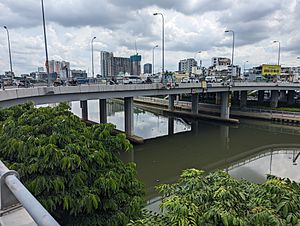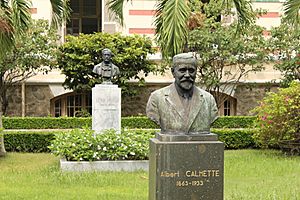Albert Calmette facts for kids
Quick facts for kids
Albert Calmette
|
|
|---|---|

Albert Calmette in 1930
|
|
| Born | 12 July 1863 |
| Died | 29 October 1933 (aged 70) Paris, France
|
| Nationality | French |
| Known for | Bacillus Calmette-Guérin antivenin |
| Scientific career | |
| Fields | Bacteriology |
| Institutions | Pasteur Institute |
Léon Charles Albert Calmette (12 July 1863 – 29 October 1933) was a French physician and bacteriologist. He was a very important scientist at the Pasteur Institute. He is famous for discovering the Bacillus Calmette-Guérin, also known as BCG. This is a special type of vaccine used to protect people from tuberculosis.
Calmette also created the first antivenom for snake venom. This medicine, called Calmette's serum, helped save many lives from dangerous snake bites.
Contents
Albert Calmette's Early Life and Work
Calmette was born in Nice, France. He wanted to join the Navy and become a doctor. So, in 1881, he started studying at the School of Naval Physicians in Brest.
In 1883, he began working in the Naval Medical Corps in Hong Kong. There, he worked with Dr. Patrick Manson. Dr. Manson studied how mosquitoes spread a tiny worm that causes a disease called elephantiasis. Calmette earned his medical degree by studying this disease.
Later, Calmette worked in other places like Saint-Pierre and Miquelon and West Africa. In Africa, he researched diseases such as malaria and sleeping sickness.
Working with Louis Pasteur
In 1890, Calmette returned to France. He met Louis Pasteur, a very famous scientist, and Emile Roux. Roux was his teacher in a class about bacteria. Calmette became a close helper to Pasteur.
Pasteur asked Calmette to start and lead a new part of the Pasteur Institute in Saigon (now Ho Chi Minh City) in 1891. There, Calmette focused on toxicology, which is the study of poisons. This field was connected to immunology, the study of how the body fights off diseases.
He studied poisons from snakes, bees, and plants. He also helped make vaccines against smallpox and rabies. He even did research on cholera.
Developing Antivenom for Snake Bites
In 1894, Calmette came back to France. He worked to create the first antivenom to treat snake bites. He made this medicine using special blood from horses that had been given small amounts of venom. This antivenom was called Calmette's serum.
Later, a Brazilian doctor named Vital Brazil continued this work. He developed many other antivenoms for snakes, scorpions, and spiders. Calmette also helped create a medicine to fight the bubonic plague, also known as the Black Death. He worked with Alexandre Yersin, who discovered the germ that causes plague.
Leading the Pasteur Institute
In 1895, Emile Roux put Calmette in charge of the Pasteur Institute's branch in Lille, France. Calmette stayed there for 25 years. In 1901, he opened the first special clinic in Lille to help people with tuberculosis. He named it after Emile Roux.
In 1904, he started the "Northern Antituberculosis League." This group still works today to fight tuberculosis. Calmette also helped set up an Institute branch in Algiers in 1909. In 1918, he became the assistant director of the main Pasteur Institute in Paris.
Researching a Tuberculosis Vaccine
Calmette's most important scientific work was trying to create a vaccine for tuberculosis. At that time, tuberculosis was a deadly disease. In 1882, a German scientist named Robert Koch found the germ that causes tuberculosis.
In 1906, a veterinarian named Camille Guérin discovered something important. He found that being immune to tuberculosis was linked to having living tuberculosis germs in the blood. Calmette and Guérin worked together. They tried to make a weaker version of the tuberculosis germ from cows. This weaker germ would help people become immune without getting sick.
This special preparation was named Bacillum Calmette-Guérin, or BCG. They made the germ weaker by growing it in a special liquid containing bile. From 1908 to 1921, Calmette and Guérin worked hard to make the germ less and less harmful.
Finally, in 1921, they used the BCG vaccine to successfully vaccinate newborn babies in Paris. This was a huge step forward in medicine.
Challenges with the BCG Vaccine
However, the vaccination program faced a big problem in 1930. In Lübeck, Germany, 72 vaccinated children became sick with tuberculosis. This happened because some of the vaccine batches in Germany were accidentally contaminated with stronger germs.
This event deeply upset Calmette. Mass vaccination of children started again in many countries after 1932. New and safer ways to make the vaccine were put in place. Calmette passed away in Paris one year after the Lübeck incident.
Calmette's Legacy
Today, Albert Calmette's name is still remembered in many places. In Ho Chi Minh City, Vietnam, some streets are named after him. A bridge completed in 2009 is also called "Calmette Bridge."
In Cambodia, a major hospital is named Calmette Hospital in his honor. His work on the BCG vaccine continues to save lives around the world.
Images for kids
See also
 In Spanish: Albert Calmette para niños
In Spanish: Albert Calmette para niños




